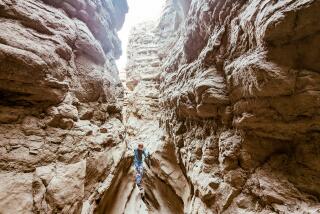Some Keys to Good Florida Hikes
- Share via
They have been called America’s Caribbean Isles, the Conch Republic, the only West Indies you can drive to. But most travelers just call them the Keys, islands of simple pleasures and more than a little eccentricity.
The Keys are far from a perfect paradise. As novelist Joy Williams, who is also the author of “The Florida Keys: A History and Guide” (Random House), said recently: “Man has fallen upon Florida like an axe murderer. Sometimes Florida breaks my heart.”
The environmentally minded traveler to the Keys who remains on Florida’s Highway 1 could very well see a Florida that’s a heartbreaker. Long stretches of the highway are astonishingly tacky. There is no length of California’s Highway 1 as horrid as some of the stretches of Florida’s Highway 1 from Miami to Key West.
But between the highway and far horizon is a more beautiful world awaiting discovery. It’s a natural world of mangrove swamps and quiet lagoons, awesome sunsets and subtropical hardwood forests on raised bits of land called hammocks.
Keys travelers chart their course by Mile Markers--green signs with white numerals posted on Highway One’s right shoulder. The Mile Markers direct you to some of the Keys’ best natural attractions--those you can explore on foot.
Best hiking bets in the Keys:
1. Key Largo: John Pennekamp State Park (MM 103).
Canoeists and kayakers follow trails through mangrove marshes, and hikers can stretch their legs on a couple of short footpaths. At the park visitors center are interpretive displays and an aquarium.
Surely the best of the park is beneath the surface. The nation’s first underwater park protects an extensive coral reef and attracts divers from around the world.
2. Lignumvitae Key (MM 79).
Most of the Keys have suffered irreparable ecological damage. Not so Lignumvitae, which preserves the tropical forest primeval, the last unaltered stand in Florida. The lignumvitae that names the island is an incredibly hard hardwood, once used by shipbuilders for gears and pulleys.
The island was saved from golf course/resort development by the Nature Conservancy, and is now open to the public. Rangers escort small groups to the Key from nearby Long Key Recreation Area. More information and reservations: (305) 664-4815.
3. Vaca Key: Museum of Natural History of the Florida Keys, Marathon (MM 50).
This brand-new museum that opened last month features a recreated coral reef. Visitors “dive” down 40 feet to look at the fish. Interpretive exhibits explore the Keys’ natural history and their colorful human history.
Behind the museum is Crane Point Hammock, which is a kind of living museum of the tropics. Pigeon plum, paradise tree, wild dilly, Spanish stopper and strangler fig are some of the intriguing names of the trees visited by a quarter-mile nature trail.
4. Pigeon Key: Old Highway Bridge (MM 47).
Two miles of the old Overseas Highway (closed to vehicles) heads out over a long bridge to Pigeon Key, originally a railroad camp. Preservation-minded Floridians are working to open a railroad museum on the Key.
The narrow old highway bridge was bypassed in 1982 when the parallel Seven Mile Bridge was completed. The walk is a chance to get a grand view of the Keys, surrounded by water.
5. Bahia Honda Key: Bahia Honda State Recreation Area (MM 37).
A nature trail meanders around a lagoon, graced by that wispy beauty, the silver palm. Rare species such as satinwood tree and dwarf morning glory grow in the park.
The Keys, for the most part, are beachless. Not so Bahia Honda, which has a swimming/windsurfing/tanning beach on the Atlantic side that is a delight to saunter.
6. Big Pine Key: National Key Deer Refuge (MM 30).
It’s easy to imagine yourself a castaway in Lilliput when you stand, Gulliver-like, next to the diminutive Key deer. The deer, a rare subspecies of the Virgin white tail, stand two feet tall and weigh in at 75 pounds.
Brought back from the edge of extinction by dedicated conservationists, the herd now numbers 300-something. The main threat to the deer these days is auto traffic. As the roadside signs warn: “Drive Deer-fensively.”
A 3/4-mile nature trail explores Watson’s Hammock, a pine and hardwood forest. Interpretive displays along Jack Watson Nature Trail tell the story of the key deer and their refuge.
7. Big Pine Key: Blue Hole (MM 30).
Blue Hole is a freshwater sink with a resident alligator. Until recently, the nearby Big Pine Baptist Church used Blue Hole for baptisms, despite the gator.
Beyond the hole, a trail leads off to a series of cement canals, used for mosquito control until the 1940s.
HIKING / Florida Keys
WHERE: Key Largo to Key West.
DISTANCE: Quarter mile to 4 miles.
TERRAIN: Mangrove swamp, subtropical forest.
HIGHLIGHTS: Florida Bay and Atlantic Ocean ecosystems, water sports.
PRECAUTIONS: Heat, humidity, biting bugs.
FOR MORE INFORMATION: Call the Florida Keys & Key West Visitors Bureau at (800) 352-5397.
More to Read
Sign up for The Wild
We’ll help you find the best places to hike, bike and run, as well as the perfect silent spots for meditation and yoga.
You may occasionally receive promotional content from the Los Angeles Times.






